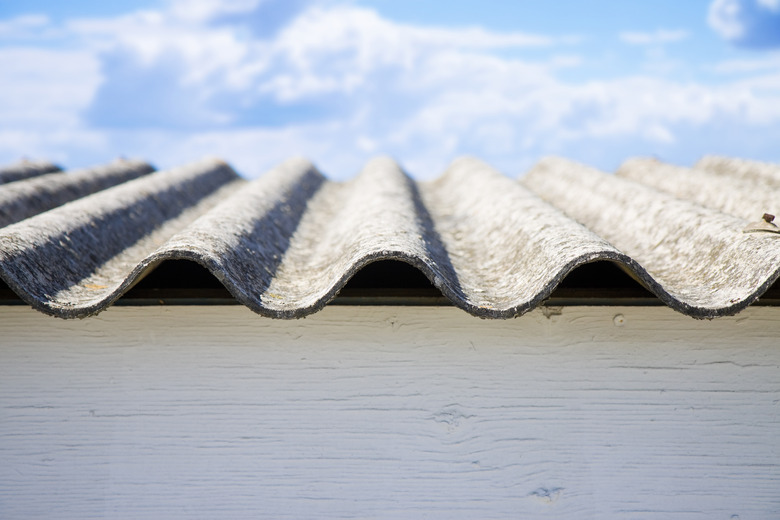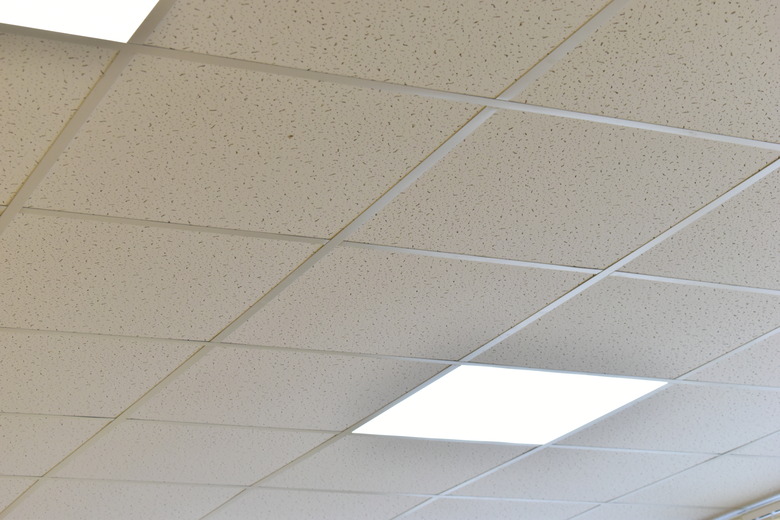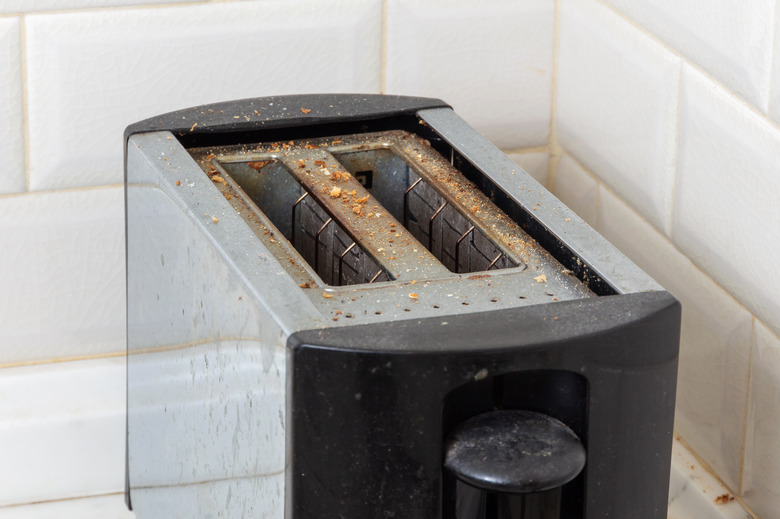14 Home Products And Materials That Contain Asbestos Fibers — And What To Do If You Find Them In Your House
We may receive a commission on purchases made from links.
While it has been known or at least suspected since the 1930s that asbestos fibers can cause mesothelioma (a type of lung cancer), it wasn't until the 1970s that products containing asbestos were severely restricted by the Environmental Protection Agency. By then, there were many uses of asbestos — in common products and materials found in homes. The material is a mineral fiber that is very strong and good for fireproofing — attributes that manufacturers thought could improve their products. It was even woven into fireproof clothing.
Most homes built before the 1980s likely have some products that contain asbestos fibers. The first instinct of many homeowners is to rip out the asbestos-containing materials, but that is actually not always the best course of action. Asbestos fibers do not have major health effects until they become airborne and are inhaled. If you've found a presence of asbestos in the home, leaving it alone or encapsulating or sealing it is often the best strategy because this method does not disturb the material and therefore does not create airborne asbestos fibers.
Identifying Asbestos Fibers
Identifying Asbestos Fibers
As a homeowner, limiting asbestos exposure in a responsible way will help keep your family safe. It is good information to have should remodeling plans call for demolition work in the future because demolition work (even sanding) may release the fibers into the air. In some areas, you are even required to disclose asbestos-containing construction materials when you sell your house since it could potentially pose a high risk for someone developing an asbestos-related disease.
On some products, you may be able to find a manufacturer's name or logo, and you can contact them to determine whether the product contains asbestos. Many well-known building materials companies that are in business today once produced products containing asbestos fibers.
An alternative is to have the suspect material tested. You can perform some tests yourself using kits where you take the sample and then send it to a laboratory, or you can hire a testing firm.
But sometimes, removal is the only option. Asbestos removal and disposal can be expensive, so be sure to deal with a qualified asbestos abatement contractor.
Asbestos Fibers in Exterior Products
Asbestos Fibers in Exterior Products
Roofing Products. For a time, it seemed that just about every component in a residential roofing system contained some asbestos fibers, including the asphalt shingles, the felt underlayment and the mastic and coatings used to seal roof penetrations. Roofing products that contain asbestos have been phased out over the years, but some remain on house roofs.
Asbestos was also used in the production of square, cement-type shingles that are usually gray and black. Many corrugated, cementlike panels that were commonly used to cover the walls of garages, sheds and other outbuildings also contained asbestos.
Siding. Asbestos added strength and provided fire protection to cement-based siding shingles up until the 1980s. The shingles are usually 12 x 24 inches and often contain a pressed wood-grain pattern. Don't confuse these products with modern fiber cement siding or very high-end vinyl siding that also has this wood-shingle look.
Neither roofing nor siding products that contain asbestos pose any danger if they are in good condition. If the products do need to be removed, consult a qualified contractor.
Asbestos Fibers in Insulation
Asbestos Fibers in Insulation
Vermiculite Insulation. Vermiculite is a mineral-based, loose-fill insulation that resembles small pebbles that are up to about 1 inch in size. It can be a grayish-brown or a silvery-gold in color. Vermiculite is a natural product that by itself is fireproof, lightweight and odorless. About 70 percent of the vermiculite used in attic and wall insulation originated from one mine in Montana. Unfortunately, the mine also contained asbestos that contaminated the vermiculite.
Vermiculite installed in the attic is probably exposed to the air. So, it is best to avoid using the attic or storing items there. Removal should be handled by a qualified contractor.
Pipe and Duct Insulation. Products that contain asbestos fibers include insulated heating ducts, water pipes and steam pipes. Very old boilers may also be covered with an asbestos insulation product. The material may look like a cementitious coating, or it takes the form of a pipe wrap that usually has a paper or cardboard outer layer.
Asbestos Fibers in Ceiling Materials
Asbestos Fibers in Ceiling Materials
Ceiling Tiles. Tiles used in suspended ceilings that are held in place by a metal grid often contain asbestos if they were manufactured before 1980. Many of these tiles were used in finished basements to hide overhead pipes and electrical work.
The tiles are usually rather large, such as 24 x 24 inches and larger, and they are often white or off-white in color. This is one type of product that may contain a manufacturer's name on the product. Tiles that were directly attached to the ceiling rather than suspended in a grid may have been installed with mastic adhesive that can also contain asbestos.
Popcorn Ceilings. To hide cracks and other damage in ceilings, many people applied a textured paint that resulted in an uneven surface that concealed imperfections. These are called popcorn ceilings, but a variety of different textures is possible. The technique is still in use today but without asbestos-containing materials. If the finish was applied prior to 1980, it may contain asbestos fibers.
Wall and Floor Products
Wall and Floor Products
Drywall Products. Many manufacturers used asbestos in drywall panels as well as in drywall joint compound and seam tape. If the drywall was installed prior to the 1980s, it may contain asbestos.
Vinyl Floor Tiles and Sheets. Asbestos made vinyl tiles and sheet products stronger and more fire-resistant. Often, the backing or mastic used with the tiles also contains asbestos. These tiles are usually 9 x 9 inches or 12 x 12 inches, although some 18 x 18 tiles were also produced. Asphalt was a primary ingredient in the tiles, so they tend to be brown or dark gray. The color can fade over the years.
Removing vinyl tile is a messy job that involves scraping up the tile and the mastic. Removing a floor that contains asbestos will often lead to airborne asbestos fibers. Consult with a qualified contractor for this type of demolition.
Caulks, Sealants, Window Putty. The same qualities that made asbestos attractive for other products apply to caulks, sealants and window putty as well. Age will determine if asbestos is present.
Other Products that May Contain Asbestos
Other Products that May Contain Asbestos
Fireplace Liners and Flues. here was often asbestos found in fireplace fireboxes and chimney flues. It is not used anymore, but it is still present in older homes.
Artificial Logs. Imitation logs and embers found in older gas-fired stoves can contain asbestos. Damaged components could lead to the release of asbestos fibers.
Fireplace and Stove Surrounds. To make the areas around wood-burning and gas-burning stoves and fireplaces heat-resistant, homeowners often installed millboard, cement sheets and paper products that all contain asbestos. Asbestos was also used in fireplace mortar and in the gaskets that seal the doors on wood and gas stoves.
Appliances. Common appliances, such as toasters, hair dryers, clothes dryers, ovens, coffee pots, bottle warmers and anything that produced heat or reacted to heat, often contained asbestos because of its insulating abilities. Most present little risk because even if they are still in use, the material is usually contained.
Apparel. Asbestos fibers were woven together with various fabrics. This led to many kitchen-centered items, such as pot holders, placemats, dish towels and aprons. In other parts of the home, asbestos-containing products included electric blankets and ironing board covers.
Tip
It's a good idea to get rid of the asbestos-containing products that are easy to remove from your house, like appliances and apparel. However, for more permanent items like flues and stove surrounds, they won't pose a problem unless it is friable asbestos (a material or product that contains more than one percent asbestos by weight or area) or damaged so that it releases fibers into the air. If you're unsure of an item, have it inspected by an asbestos abatement contractor.


